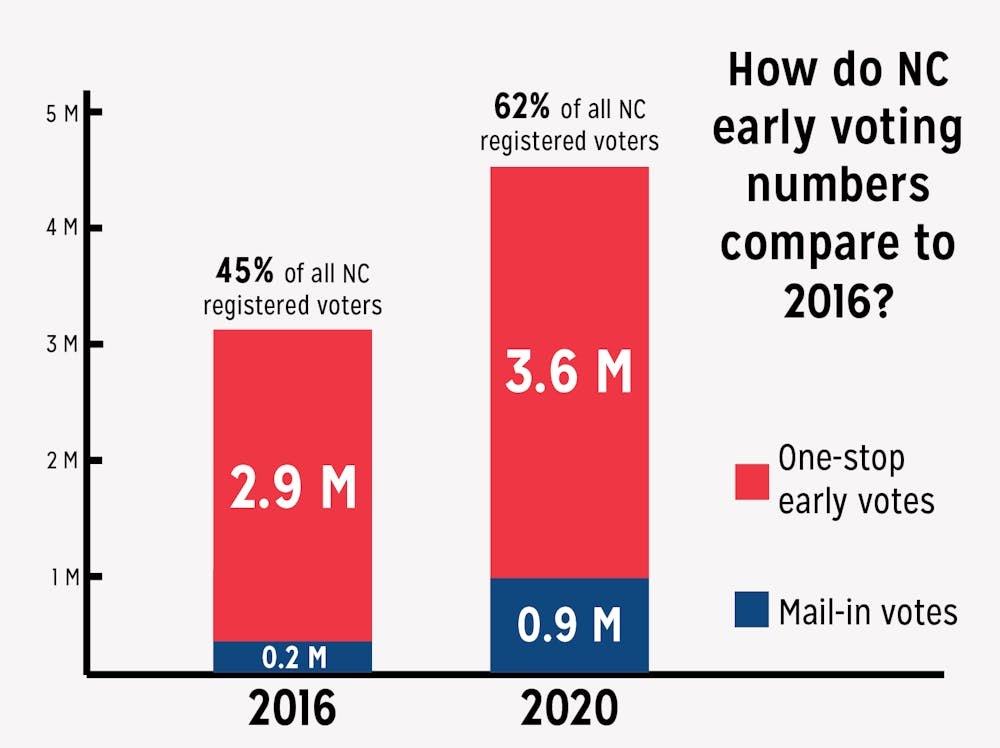For more election coverage from across North Carolina, visit One Vote N.C., a collaborative between The Chronicle and six other student newspapers that aims to help college students across the state navigate the November election
More than 4.5 million absentee ballots have been cast in North Carolina in advance of Election Day.
As of Sunday morning, 4,531,466 absentee ballots have been cast, which is about 61.7% of registered voters in the state. Of these, 3,603,023 voters cast ballots during one-stop early voting from Oct. 15 to Oct. 31, greater than the total number of absentee ballots cast in 2016.
That year, just shy of 3 million votes were cast during early voting and 155,326 were cast by mail.
Although the numbers have increased, Sunshine Hillygus, professor of political science and public policy, warned against jumping to conclusions based on early voting statistics.
“We have to be very cautious in interpreting early voting numbers,” Hillygus said at a media briefing. “We know from the research that a lot of the people voting early tend to be people who would have voted on election day. It’s not expanding the electorate.”
Hillygus also stated that the pandemic or “frankly even just a rainstorm” could hinder voters’ abilities to make it to the polls.
“When you look at the pool of people likely to vote on Election Day, it’s more likely a distraction or barrier might stand in their way,” she said.
Durham County contributed 162,338 absentee ballots to the state total, with 45,872 of those being mail-in ballots. In September, Durham had cast the third most mail-in ballots behind Mecklenburg and Wake Counties. Overall, Durham placed fifth behind Wake, Mecklenburg, Guilford and Forsyth counties for absentee voting. Each of those counties has at least one major city, including Raleigh, Charlotte, Greensboro and Winston-Salem respectively.
Statewide, registered Democrats cast 37.4% of absentee ballots, with Republicans casting 31.7% and unaffiliated voters casting 30.3%, while voters affiliated with the Libertarian, Constitution and Green parties cast a combined 0.54% of absentee ballots.
In Durham, registered Democrats cast 54% of absentee ballots, which aligns with the proportion of registered Democrats in the entire county.
In total, 111,628 of Durham’s absentee ballots were cast by white voters, 79,111 by Black voters, 8,071 by Asian voters, 604 by Native American voters, 3,447 by voters of two or more races and 41,895 by voters of other or undesignated races.
As of Nov. 1, 1,294 absentee ballots cast in Durham County had not been accepted—although 244 of these were later fixed. The rest were invalid for various reasons, ranging from incomplete witness information to cancelation by the voter to being flagged for a “conflict.”
Of all the ballots that had not been accepted by Nov. 1, 511 were cast by Black voters, or approximately 48.7% of non-accepted ballots. In contrast, 323 ballots, or 30.8%, were submitted by non-Hispanic white voters or white voters with undesignated ethnicities. Ballots cast by voters of color are more likely to be flagged during the review process due to mistakes or missing information, according to reports by the U.S. Election Project and FiveThirtyEight.
The increased voter turnout for this election was partially influenced by recent changes to election rules making the voting process easier. The deadline for local election boards to receive mail-in ballots was recently extended from Nov. 6 to Nov. 12, and a challenge to the rule was declined by the U.S. Supreme Court.
Megan Mullin, associate professor of environmental politics at the Nicholas School of the Environment, believes these changes need to be implemented long term in anticipation of climate change.
“A lot of what’s enabled the large early-voting numbers are these changes in election rules that have happened across the states to open more early voting centers, to allow more early voting, to allow mail-in voting. Many if not most of those changes were temporary changes for this cycle,” Mullin said in the press briefing at which Hillygus spoke. “But we need to have in mind, there is a hurricane bearing down on the Gulf Coast, there are 100,000 people in California who are evacuated from their homes, and that’s a consequence of climate-driven natural disasters that are increasing in severity and frequency over time.”
Get The Chronicle straight to your inbox
Sign up for our weekly newsletter. Cancel at any time.

Nadia Bey, Trinity '23, was managing editor for The Chronicle's 117th volume and digital strategy director for Volume 118.

